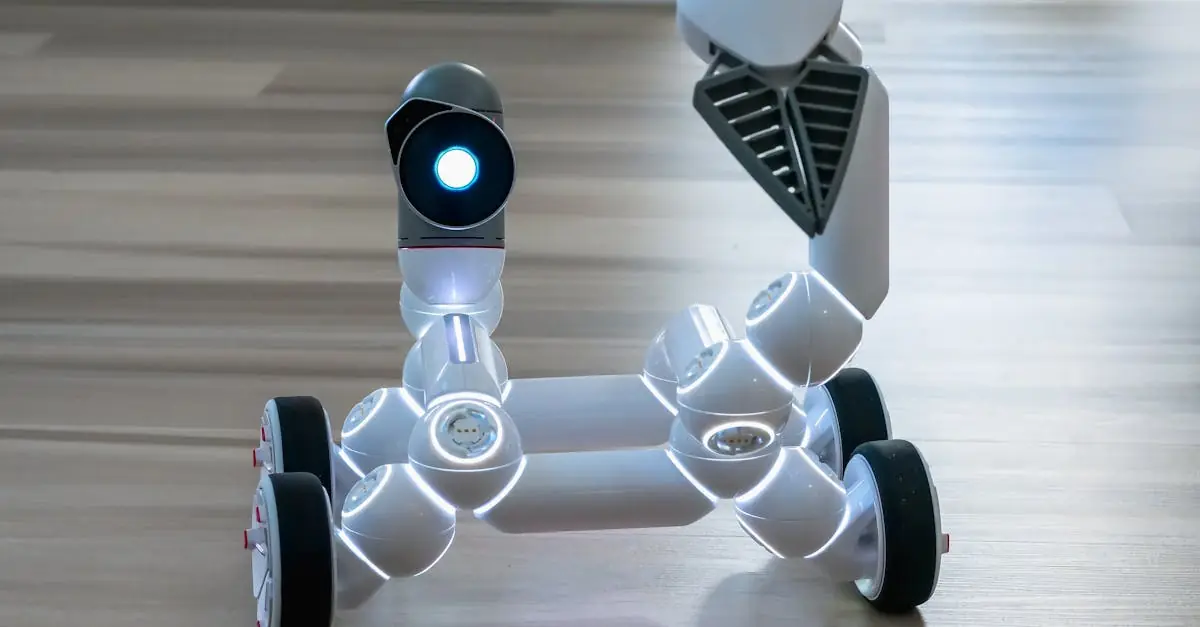Imagine waking up to the aroma of freshly brewed coffee, with your curtains gently parting to let in the morning sun—all without lifting a finger. Smart home technology is no longer just a futuristic dream; it’s here and revolutionizing how people live. From voice-activated assistants to smart thermostats, these gadgets are making homes not just smarter but also a lot more fun.
As technology continues to evolve, it’s shaping our living spaces in ways we never thought possible. Forget about the days of fumbling for light switches or adjusting the thermostat manually. With smart home tech, convenience is the name of the game. It’s like having a personal assistant who never takes a coffee break! Get ready to explore how these innovations are transforming everyday life into something extraordinary.
Table of Contents
ToggleOverview of Smart Home Technology
Smart home technology integrates various devices and systems, enhancing how individuals interact with their living spaces. Voice-activated assistants simplify tasks by allowing hands-free control over lights, temperature, and security systems. Companies like Amazon and Google lead the market, continuously innovating through products and services that offer seamless integration.
Remote monitoring features provide homeowners with peace of mind. Security cameras, doorbell cameras, and motion sensors enable users to access real-time feeds from their smartphones. Energy-efficient devices, such as smart thermostats and LED lighting, help lower utility bills and reduce environmental footprints, reinforcing the push toward sustainable living.
Smart appliances transform everyday tasks into automated processes. Refrigerators can suggest grocery lists based on inventory, while washing machines can be programmed to operate remotely. Home entertainment systems sync with mobile devices, allowing users to control media playback from anywhere in the house.
Data collected from smart devices creates personalized experiences. Algorithms assess user habits, optimizing energy consumption and tailoring suggestions to enhance comfort. Interoperability among various brands and devices fosters an ecosystem where all components work harmoniously.
The rise of smart home technology reflects a broader shift in lifestyle choices. Increased connectivity shapes social interactions by bridging gaps between individuals and their environments. Users enjoy more convenient, efficient methods to manage their homes, ultimately elevating the overall quality of life.
Benefits of Smart Home Tech
Smart home technology significantly improves daily living experiences. Numerous advantages arise from these innovations, enhancing both convenience and energy efficiency.
Convenience and Automation
Voice-activated assistants streamline daily tasks. With a simple command, users can control lighting, temperature, and even the coffee maker, creating a seamless living environment. Smart appliances automate chores like washing clothes and adjusting cooking functions. Remote access to devices allows homeowners to manage their homes from anywhere, providing peace of mind. Integrating systems offers a unified platform, reducing the complexity of multiple applications. Smart locks enhance security, enabling keyless entry and remote monitoring. Overall, these elements contribute to a more enjoyable and stress-free living experience.
Energy Efficiency
Energy-efficient devices play a crucial role in smart home technology. Smart thermostats adjust heating and cooling based on user habits, lowering energy consumption and reducing utility costs. LED lighting systems connected to smart controllers optimize brightness and usage patterns. These innovations not only promote sustainable living but foster environmentally responsible behavior. Data analytics from smart devices provide insights into energy use, helping homeowners make informed decisions. As a result, this technology supports reduced carbon footprints while maintaining comfort within homes. Overall, smart home tech represents a significant step toward more efficient lifestyles.
Integration with Daily Life
Smart home technology seamlessly integrates into daily routines, enhancing convenience and comfort. This integration transforms how individuals interact with their living spaces.
Seamless Connectivity
Smart devices connect effortlessly to home networks, creating an ecosystem that supports various functions. Homes equipped with smart appliances, lights, and security systems promote efficiency. For instance, smart thermostats adjust temperature settings based on user habits. They interact with other devices, allowing for automated responses to changing conditions. Voice-activated assistants consolidate control, providing access to all connected devices through simple commands.
Enhanced Security Features
Security benefits significantly from smart home innovations, providing homeowners with enhanced safety measures. Smart locks eliminate the need for physical keys, enabling secure access through mobile applications. Cameras and motion sensors offer real-time monitoring, alerting users to potential threats. Integration with smart lighting systems can deter intruders by simulating occupancy. Notifications sent to smartphones keep residents informed about security events, ensuring peace of mind when away from home.
Future Trends in Smart Home Technology
Smart home technology continues to evolve, introducing exciting trends that shape future living environments. Innovations in AI and sustainability stand out as key drivers of this change.
AI and Machine Learning Applications
AI and machine learning play significant roles in enhancing smart home efficiency. These technologies learn user preferences to automate daily tasks, adjusting settings like temperature and lighting to create optimal conditions. Predictive analytics enable devices to anticipate needs, such as smart refrigerators suggesting recipes based on available ingredients. Voice recognition has improved, allowing systems to understand multiple users and respond accurately. Real-time data processing enhances security measures, making threat detection more reliable. Overall, AI’s integration into smart homes improves convenience and personalization.
Sustainability and Eco-Friendly Innovations
Sustainability becomes increasingly vital in smart home technology. Smart devices contribute to energy savings by optimizing consumption through data analytics. Smart thermostats automatically adjust heating and cooling based on occupancy patterns, effectively reducing utility costs. Solar energy integration is becoming more prevalent, allowing homeowners to harness renewable energy sources. Efficient appliances, such as those with Energy Star ratings, minimize electricity use while offering advanced functionalities. Eco-friendly innovations promote a balanced relationship with the environment, supporting a shift toward greener living spaces.
Challenges and Considerations
Smart home technology presents various challenges. Two key areas of concern are privacy and security, as well as affordability and accessibility.
Privacy and Security Concerns
Privacy remains a critical issue with smart home devices. Data collection occurs through voice-activated assistants and security cameras. Unauthorized access to personal information can happen if devices lack robust security measures. Users often worry about potential hacking and data breaches. Ensuring encryption and secure configurations significantly reduces risks. Regular software updates also play a crucial role in protecting privacy. Awareness of privacy policies from manufacturers is essential for users to understand data handling practices.
Affordability and Accessibility
Affordability impacts widespread adoption of smart home technology. Initial costs can deter consumers from investing in smart devices. High-tech products often come with premium price tags, making it crucial for developers to offer budget-friendly options. Accessibility issues arise for individuals with disabilities, requiring inclusive design in devices. Providing adaptive features enhances usability for all. As the market evolves, companies increasingly focus on lowering costs while improving functionality. Overall, creating affordable and accessible smart home solutions broadens the potential user base significantly.
Smart home technology is undeniably reshaping the way individuals live and interact with their environments. By enhancing convenience security and energy efficiency it’s paving the way for a more connected lifestyle. As advancements continue to emerge the integration of AI and sustainable practices will further elevate the quality of life in homes.
While challenges like privacy concerns and affordability remain the potential for smart home solutions to transform everyday living is immense. With ongoing innovations and an increasing focus on inclusivity these technologies are set to create a future where homes are not just smarter but also more responsive to the needs of their inhabitants. Embracing these changes can lead to a more enjoyable and efficient living experience for everyone.



